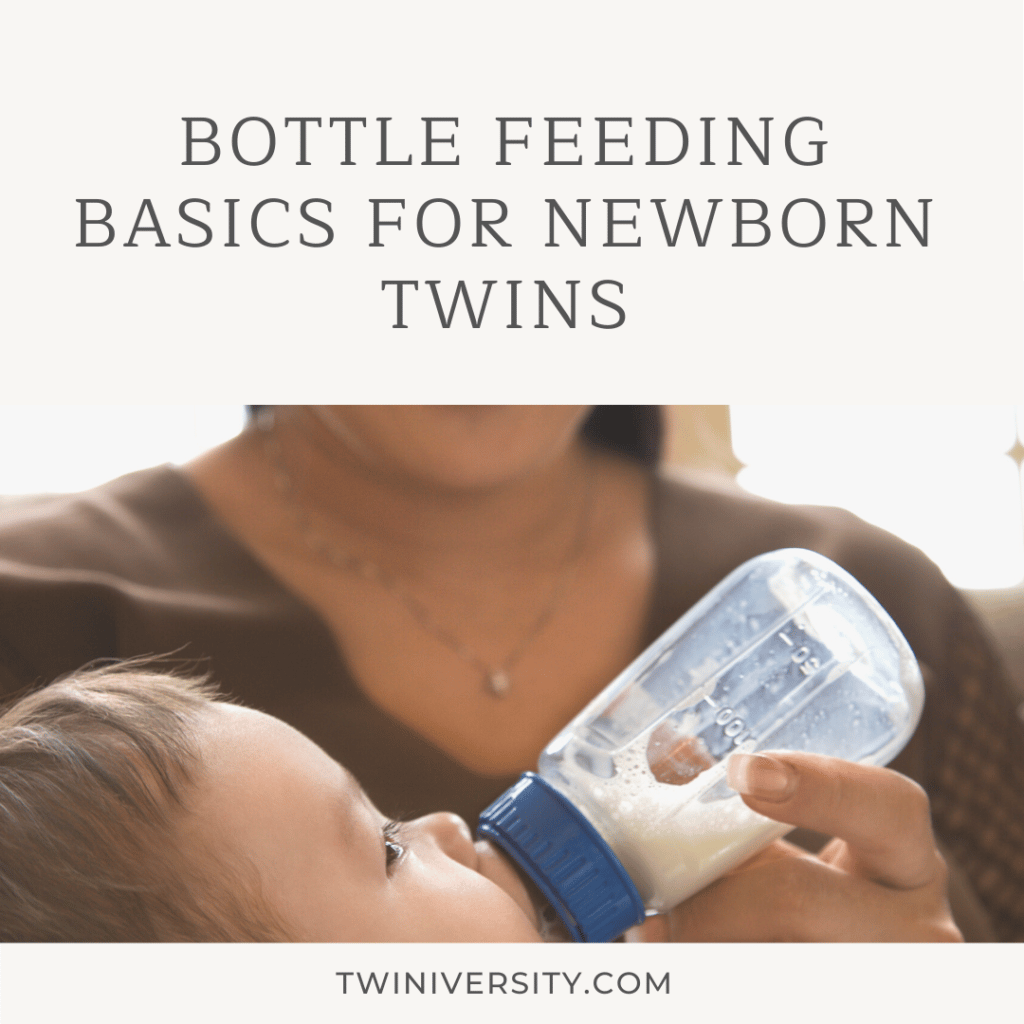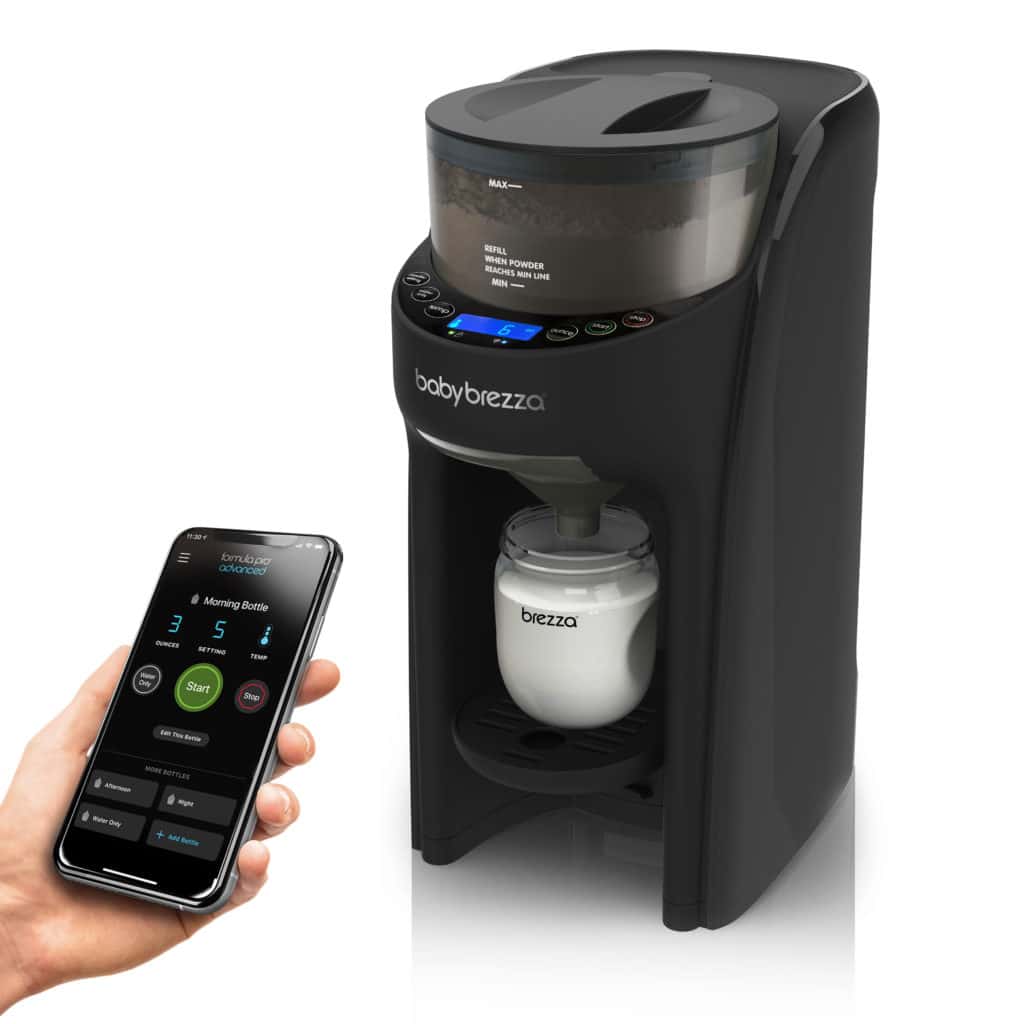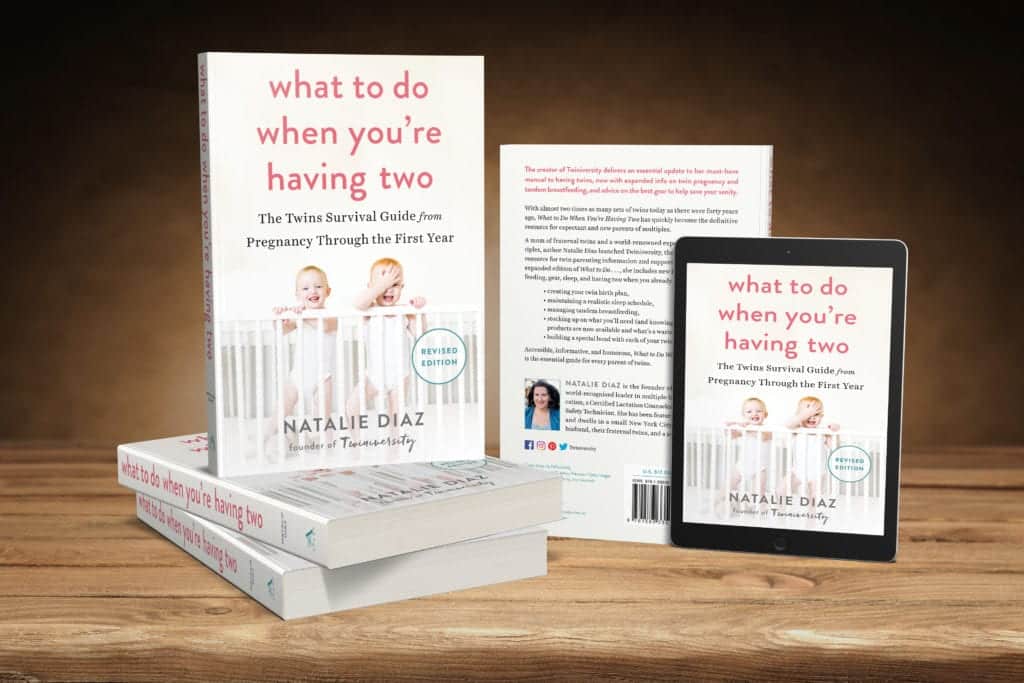Last updated on July 22nd, 2024 at 06:22 pm
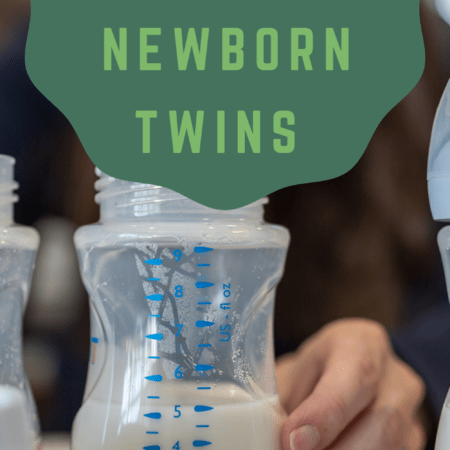
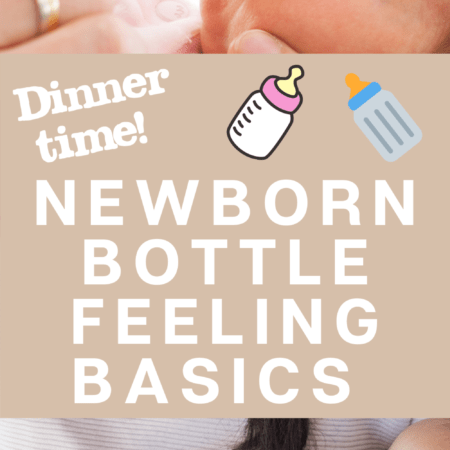
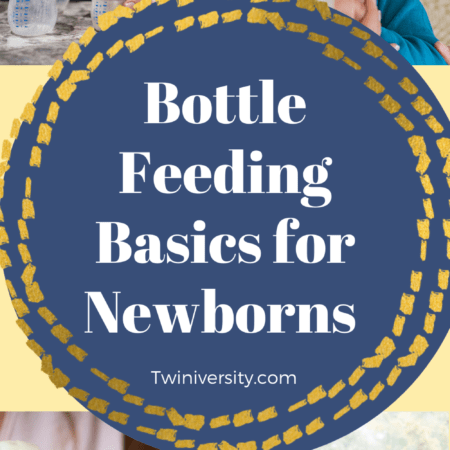
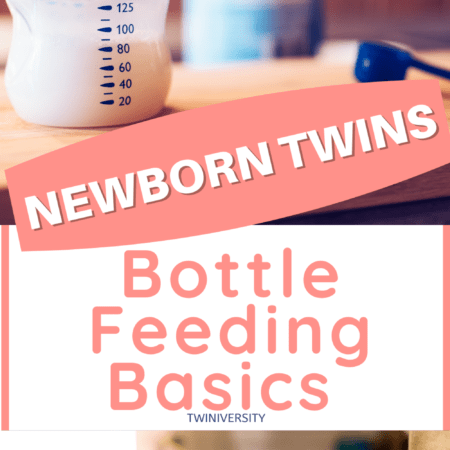
Every new parent has that moment where they feed their baby for the first time. For parents of twins, we get to do that twice! You may have fed babies before or you may be totally new to this feeding thing. Not to worry — we’ve got you covered with the bottle feeding basics. We’re going to take you step by step through the basics of preparing to bottle feed your twins, actually feeding your twins, and what to do when you’re finished feeding your twins. Let’s break it down, shall we?
What to Keep in Mind When Bottle Feeding Newborn Twins
Before we jump in, if you’re a first time parent of twins there are a few things you should know about bottle feeding newborn twins.
Newborn Stomachs Are Tiny
Did you know that a baby’s stomach is only the size of a cherry at birth? At 2 days old it’s the size of a walnut. At one week it’s the size of an apricot and at one month it’s the size of an EGG! No wonder you have to feed your babies at least every three hours! Their stomachs are too small to hold more than a small amount of milk at a time, so you will have to feed them frequently around the clock. It’s important to keep track of how often you’re feeding your babies to make sure they are growing at a proper rate. Keeping a daily log of your twins’ feedings will be critical in the first month, if not longer. We recommend keeping your twins on the same feeding and sleeping schedule to make your day more predictable and give you time for breaks.
Newborn Twins Are Often Gassy
Babies’ stomachs go through a lot of development in the first few months of life and spit-up, gas, and digestive problems are common. And since twins are often born early and are a bit behind in development, their stomachs tend to be more sensitive than the average baby’s. Using anti-colic bottles, gas remedies, and limiting air in the formula may help to decrease digestive problems. However, if your child is throwing up most of their feedings, not able to eat most of their bottle, and not gaining weight, talk to your pediatrician and ask for a referral to a pediatric gastroenterologist, who specializes in child digestive problems.
Newborn Babies Are Floppy
Newborn babies are like Jell-O. They have very little muscle tone when they are first born, but that will develop as they grow and with the help of tummy time. In the meantime, you need to properly support your babies to help them to eat better. Bottle feeding two babies at once can be very difficult when they are super little because they don’t have the ability to hold their heads up well.
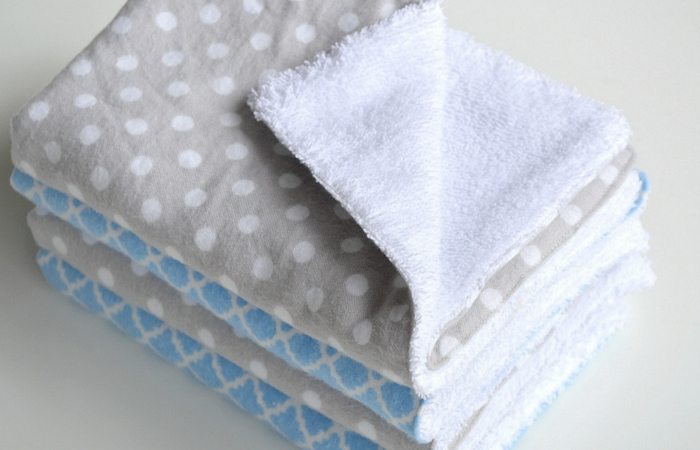
Prep the Feeding Area
Before you even go into the kitchen to prepare the bottles, prep the feeding area for the whole day. You’ll want a big stack of burp cloths and absorbent bibs at the ready. Get some good pillows to prop up your arms and support your back. Fill up a large water bottle, grab some protein bars, and find your remote controls. Now you’re ready to head into the kitchen.
Bottles and Nipples
There’s some basics you need to know about bottles and nipples before you dive in:
- You don’t need to buy 4 oz bottles. We want you to save money and this is a great place to do so. Invest in the 8-9 oz bottles, which will last you through their entire first year.
- All bottles come with level one nipples. This is a standard flow for newborns. If you have preemies, your NICU may send you home with preemie size nipples, which is the slowest flow available. As your babies age, they may start getting frustrated that the flow is too slow and you’ll switch to level two nipples at that point. But don’t throw your level one nipples away — they are great for opening your baby’s ears on airplanes.
- Plan for 16-20 bottles for bottle feeding twins. Each baby will go through eight bottles a day so this will mean you don’t have to worry about washing bottles more than once a day.
- If you don’t have a dishwasher, just a heads up that wide-neck bottles are a little easier to clean than narrow-neck bottles.
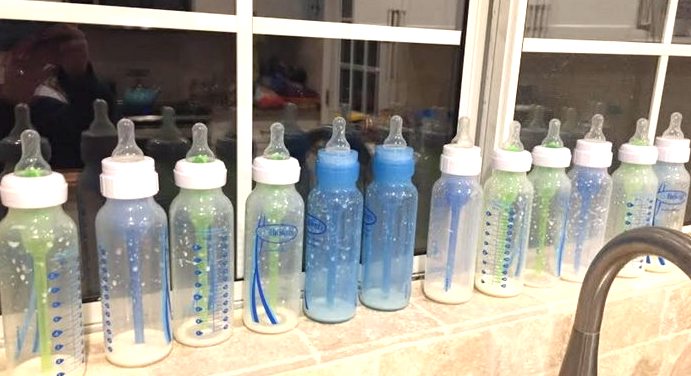
Making a Formula Bottle
When you have twins who are bottle feeding, you’ll be making at least 16 bottles a day. This gets to be really tedious and annoying! We highly recommend that you register for a Baby Brezza formula maker to help with making all those formula bottles. This will be a HUGE help for their first year of life. But if you’d prefer to make the bottles by hand (and at some point you will probably need to) here’s how to do it. Keep in mind that using powdered formula is cheaper than ready-to-feed formula, but both are available options.
- Test your tap water. You can buy a water testing kit (buy on Amazon) to check on the safety of the water from your kitchen tap. If it’s not up to par, using bottled nursery water is a fine choice.
- Wash the bottle, parts, and your hands before mixing.
- Follow the formula can instructions for mixing guidelines but make sure to measure precisely, as too much powder can cause an upset stomach for baby.
- Swirl, don’t shake. Shaking creates too much air in the formula, which will lead to lots of burping, gas, and stomach upset. Swirl the formula to mix it with the water. We admit that this isn’t as effective as shaking to completely mix the formula, so you might want to consider a formula mixing pitcher that uses a swirling technique like this one.
- Look for clumps. Hold the bottle up to the light to see if there are any clumps on the bottom that haven’t fully mixed. If so, keep swirling. Those clumps will get stuck in the nipple and stop the feeding.
- Use a formula bottle within 1-2 hours. If the bottle touches a baby’s lips and isn’t finished, it needs to be thrown out. But if a bottle isn’t used at all you can save it in the fridge for up to 24 hours.
Warming a Bottle
If your babies have ever breastfed, they will probably prefer warm milk from a bottle. But if your babies never had warm breastmilk they might not know the difference. Starting your newborn twins on room-temperature formula bottles will save you a lot of time and energy. But if your babies refuse bottles that aren’t warmed, here’s some ideas and tips to help with bottle warming:
- Keep a small slow cooker (buy on Amazon) on LOW all day with a few inches of hot water inside. Drop the sealed bottles in before heading to their room for a diaper change and by the time you’re done the bottles will be ready.
- Put the bottles in mugs of hot water to warm up while you’re diaper changing.
- Get a bottle warmer. Actually, get two.
- Or invest in a water warmer that instantly dispenses warm water for bottles.
Feeding a Bottle
Skin to Skin
Going skin to skin (where baby is only in a diaper and parent is topless) when possible at bottle feedings is ideal to help regulate your baby’s heartbeat, temperature, and promote bonding. If it’s chilly in the room, use a blanket around you and your baby. If skin to skin just isn’t working in your situation don’t fret — you will still bond with your baby.
How to Hold the Baby
As I said earlier, newborn twins can often have digestive issues such as reflux. Feeding your baby at more of an upright position (closer to 90 degrees) will put gravity on your side. This will help the formula to stay down and avoid an Old Faithful eruption.
Cradle the baby’s head in the crook of your elbow and use your forearm to support their back/rear end. Make sure their head is higher than their body. Keep your baby snuggled up close to your body to make them feel warm and secure. Place a burp cloth over your shoulder and make sure your baby is wearing an absorbent bib (buy on Amazon) to avoid having to change their outfit 8 times a day. Use as many pillows as you need to prop your arms up to reduce fatigue. You should switch sides if your arms get tired. Look into your baby’s eyes and connect with them. For parents of twins, feeding time is one of the only times you get to just focus on one baby at a time.
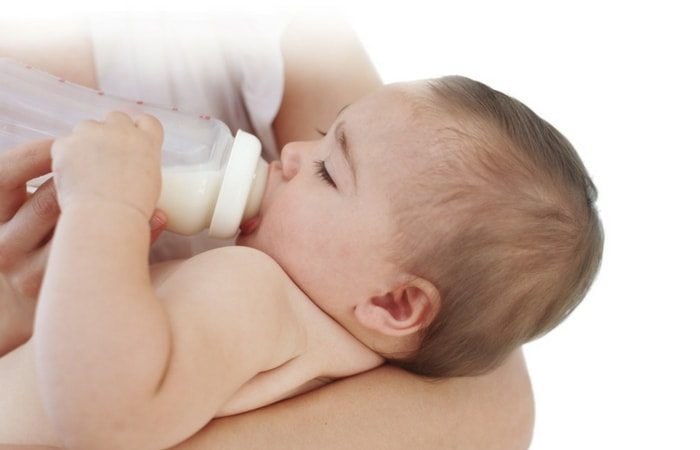
Latching
It’s difficult to determine if your baby is getting a proper latch on the bottle nipple. You may need to try out different bottles to see which one your baby likes best. With twins, try to find a bottle that they both like to avoid dealing with confusing which baby should get which bottle.
A good latch means that your baby’s tongue is under the nipple and their lips are sealed around the base of the nipple – not on the nipple tip. Getting your baby to take the bottle nipple might mean you have to get creative, such as dipping the nipple in breast milk or formula to get them started, or tickling their lips to engage them.
Paced Feeding
Doctors and lactation experts recommend using a paced bottle feeding technique to help your baby learn how to pace their eating, avoiding overfeeding and reducing spit-up. Place the nipple in your baby’s mouth and hold the bottle parallel to the floor, allowing the milk to start flowing into their mouth slowly. Every 20 or 30 seconds, you tip the nipple towards the top of baby’s mouth to stop milk flow. Then repeat throughout the feeding. As your baby gets older and learns how to pace themselves, you can stop doing this. Learn more about paced feeding.
Burping
Once your baby starts refusing the bottle, try burping them to get the gas out. Place your baby with their tummy against your shoulder and support their head. Use firm patting from the waist up to the upper back and once you hear that belch you can go back to the feeding. Check out this video of burping twins that keeps everyone happy. If there’s a lot of air in the formula, you will have to burp them more often.
After the Feeding
After the feeding is done, prop your babies up in a bouncer or other inclined position for about 20 minutes. This will help the milk to stay down in their bellies! If your babies fall asleep during this waiting period, transfer them to a firm, flat surface for sleep. If they manage to stay awake for the full 20 minutes, transition them to tummy time on the floor. Pour out any leftover formula and soak the bottles and parts in a tub of warm soapy water in the sink.
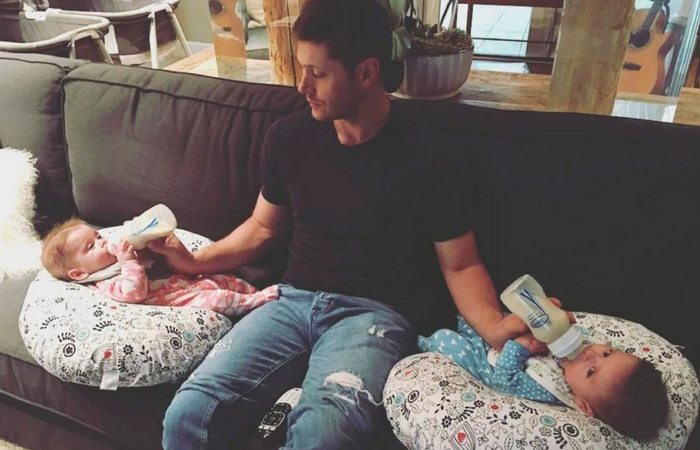
Feeding Bottles to Two Babies at Once
What if you’re all alone for feedings? As I said earlier, newborn babies are difficult to feed at the same time and it may take time for them to develop the ability to tandem bottle feed. Some parents stagger their twins by 20-30 minutes to feed each baby individually while keeping them on a close schedule. Here’s some quick tips to get you through a tandem feeding with twins:
- Feed babies in bouncy seats on the floor while you sit between them. Lean against a couch for back support.
- Another great position is placing a baby on either side of you on the couch. Use pillows to prop the babies up so they are on an incline.
- Use a rolled-up receiving blanket to support their floppy heads.
- Have pacifiers ready to soothe the other baby when you need to burp one.
- Avoid bottle propping. This is when you use something to prop up a bottle on the baby’s tummy so you don’t have to hold it up. I know that feeding two babies at once is exhausting. We’ve been there! But we don’t want you to run the risk of your baby accidentally choking on their milk.
Bottle feeding twins is a trial by fire; you will learn things about your babies as you go and what worked one day might not work the next. This is all part of the process and is to be expected. Try not to get down on yourself if a bottle feeding didn’t go as planned. Keep moving forward and have faith that it will get better with more practice. Your babies are also learning how to eat and you need to be patient with them. Once you get past the first few months it will get SO much easier, and before you know it they’ll be holding their own bottles! (Yes, that was the best day of my parenting life!!!) Hang in there, mommas and daddies. You all are doing great!
Baby Brezza Formula Pro Advanced WIFI
This post is sponsored by Baby Brezza. Scroll below to learn about the Baby Brezza Formula Pro Advanced WIFI, which is a game changer with twins.
Twin moms and dads, meet your new favorite invention. The Baby Brezza Formula Pro Advanced WIFI is the easiest way to make a warm formula bottle ever! This formula dispenser will automatically mix, heat, and dispense formula at the perfect temperature! It’s a HUGE time saver for bottle-feeding twin parents. PLUS now you can use your PHONE to make a bottle! I mean, is this for REAL? Yes! We are living in the future!!!
- Make a bottle with a touch of your phone, using the free app, or with easy-use digital controls
- Get alerts on your phone including bottle ready, low water, low formula, and no bottle present
- Customize and set up 5 different bottles – choose from 3 temperature settings and dispensing from 2-10 oz (even “water only”)
- Works with virtually all formula brands, even Similac Alimentum
- Works with all bottle brands and sizes
- Airtight formula storage
- Dishwasher-safe, removable water tank
- 1-year limited warranty (or 18 months if you buy from BabyBrezza.com)
- BPA Free
Visit BabyBrezza.com to learn more.
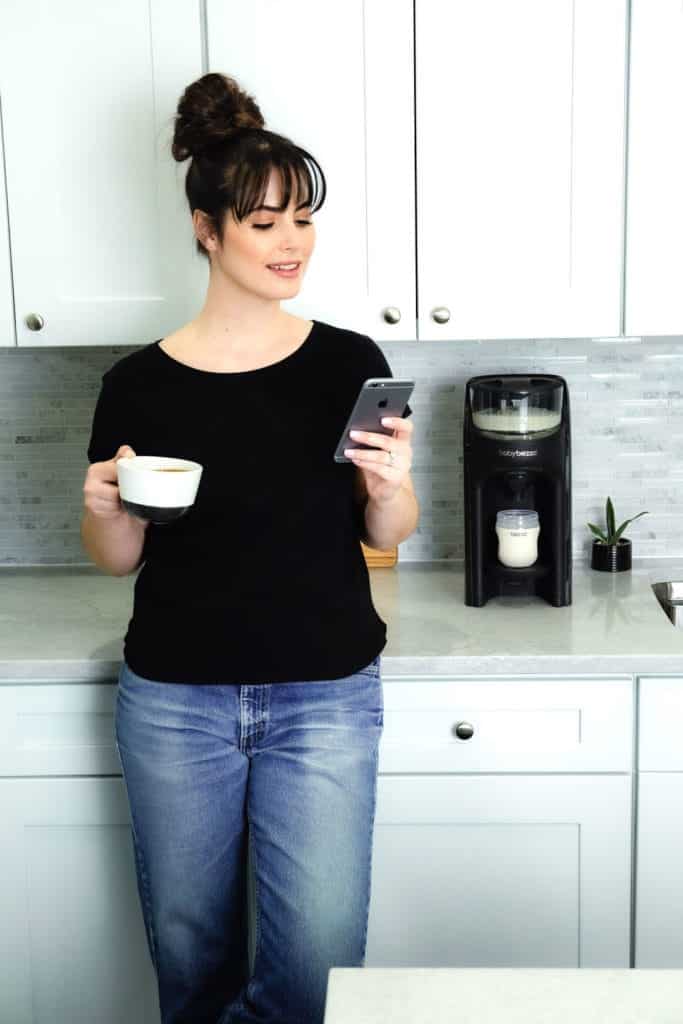
Are You a New Twin Parent?
Check out Natalie Diaz’s book:
“What To Do When You’re Having Two
The Twin Survival Guide From Pregnancy Through the First Year”
In What to Do When You’re Having Two: The Twins Survival Guide from Pregnancy Through the First Year, national twins guru and founder of Twiniversity (and twin mom herself!) Natalie Diaz provides a no-holds-barred resource about life with twins, from pregnancy and birth all the way through your duo’s first year of life.
Accessible and informative, What to Do When You’re Having Two
is the must-have manual for all parents of twins.

